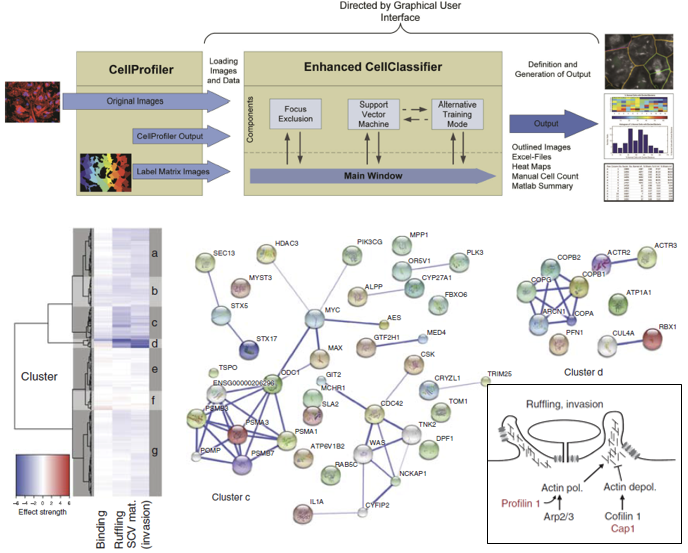S. Typhimurium host cell invasion
Infectious disease results from intricate pathogen-host interactions. In the case of invasive pathogens like S. Typhimurium, the host cell plays an essential, active part in this interaction (e.g. "membrane ruffling-dependent invasion"). We study how virulence factors trigger host cell invasion, in particular the type III secretion system 1 (TTSS-1). This is a syringe-like organelle that is used by S. Typhimurium to inject a cocktail of bacterial toxins ("effector proteins") into host cells and thereby manipulates host-cellular signalling. The TTSS-1 effector proteins SopE, SopE2 and SipA are main drivers of host cell invasion.
We are analyzing how this is achieved at the molecular level (e.g. external page Hardt et al., Cell. 1998; external page Stender et al., Mol Micro. 2000; Vonaesch et al., Cell Microbiol. 2013; Vonaesch et al., Cell Microbiol. 2014). Time lapse microscopy is used to study how the bacteria are approaching permissive host cells (Misselwitz et al., PLoS Pathog. 2012), how the bacteria dock to such cells and how this leads to effector protein injection already a few seconds after docking (Schlumberger et al., PNAS 2005; Winnen et al., PLoS One. 2008).
An automated image-based platform has been developed for high throughput screening and quantitative analysis of S. Typhimurium host cell invasion in tissue culture (Misselwitz et al., Mol Syst Biol. 2011; Franceschini et al., PNAS 2014; Rämö et al., BMC Genomics. 2014). Using this platform for genome-wide perturbation screens, the lab identifies novel host cell-factors subverted by the pathogen in order to invade (e.g. Kreibich et al., Cell Host Microbe 2015). This work is part of a collaborative project funded by SystemsX, a Swiss initiative advancing systems biology (projects external page InfectX and external page TargetInfectX).
Literature
Schlumberger, M. C., A. J. Muller, K. Ehrbar, B. Winnen, I. Duss, B. Stecher, and W. D. Hardt*. 2005. Real-time imaging of type III secretion: Salmonella SipA injection into host cells. Proc Natl Acad Sci U S A 102:12548-53. external page [Abstract]
Winnen, B., M. C. Schlumberger, A. Sturm, K. Schüpbach, S. Siebenmann, P. Jenny and W. D. Hardt*. 2008. Hierarchical effector protein transport by the Salmonella Typhimurium SPI-1 type III secretion system. PLoS One, 3(5):e2178. external page [Abstract]
Misselwitz, B., Dilling, S., Vonaesch, P., Sacher, R., Snijder, B., Schlumberger, M., Rout, S., Stark, M., von Mering, C., Pelkmans, L. and W.D. Hardt* (2011) RNAi screen of Salmonella invasion shows role of COPI in membrane targeting of cholesterol and Cdc42. Mol. Syst. Biol., 15;7:474. external page [Abstract]
Misselwitz, B., Barrett, N., Kreibich, S., Vonaesch, P., Andritschke, D., Rout, S., Weidner, K., Sormaz, M., Songhet, P., Horvath, P., Chabria, M., Vogel, V., Spori, D.M., Jenny, P. and W.D. Hardt* (2012) Near Surface Swimming of Salmonella Typhimurium Explains Target-Site Selection and Cooperative Invasion. PLoS Pathog 8(7): e1002810.doi:10.1371/ journal.ppat.1002810 external page [Abstract]
Vonaesch, P., Cardini, S., Sellin, M.E., Goud, B., Hardt, W.D.* and K. Schauer* (2013) Quantitative insights into actin rearrangements and bacterial target site selection from Salmonella Typhimurium infection of micropatterned cells. Cell. Microbiol. (11):1851-65. external page [Abstract]
Franceschini, A., Meier, R., Casanova, A., Kreibich, S., Daga, N., Andritschke, D., Dilling, S., Rämö, P., Emmenlauer, M., Kaufmann, A., Conde-Álvarez, R., Low, S.H., Pelkmans, L., Helenius, A., Hardt, W.D., Dehio, C., and C. von Mering* (2014) Specific inhibition of diverse pathogens in human cells by synthetic microRNA-like oligonucleotides inferred from RNAi screens. PNAS 111(12):4548-53. external page [Abstract]
Rämö P, Drewek A, Arrieumerlou C, Beerenwinkel N, Ben-Tekaya H, Cardel B, Casanova A, Conde-Alvarez R, Cossart P, Csúcs G, Eicher S, Emmenlauer M, Greber U, Hardt WD, Helenius A, Kasper C, Kaufmann A, Kreibich S, Kühbacher A, Kunszt P, Low SH, Mercer J, Mudrak D, Muntwiler S, Pelkmans L, Pizarro-Cerdá J, Podvinec M, Pujadas E, Rinn B, Rouilly V, Schmich F, Siebourg-Polster J, Snijder B, Stebler M, Studer G, Szczurek E, Truttmann M, von Mering C, Vonderheit A, Yakimovich A, Bühlmann P and Dehio C* (2014) Simultaneous analysis of large-scale RNAi screens for pathogen entry. BMC Genomics. 15:1162. external page [Abstract]
Vonaesch, P., Sellin, M.E., Cardini, S., Singh, V., Barthel, M. and W.D. Hardt* (2014) The Salmonella Typhimurium effector protein SopE transiently localizes to the early SCV and contributes to intracellular replication. Cell. Microbiol. (12):1723-35. external page [Abstract]
Kreibich S, Emmenlauer M, Fredlund J, Rämö P, Münz C, Dehio C, Enninga J, Hardt WD (2015) Autophagy Proteins Promote Repair of Endosomal Membranes Damaged by the Salmonella Type Three Secretion System 1. Cell Host Microbe. 18(5):527-37. [external page Abstract]
